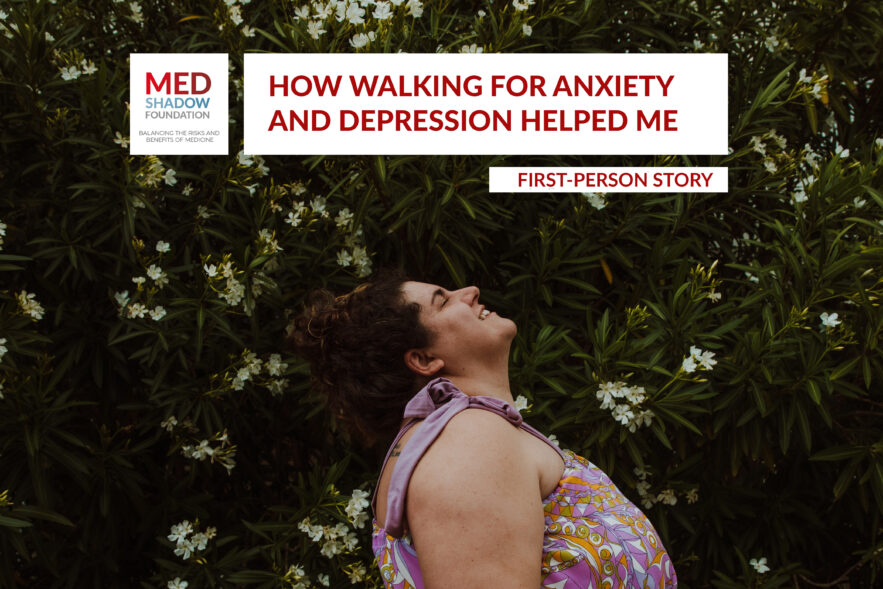May is Mental Health Awareness Month, aimed at bringing awareness and solutions to all those that struggle with mental health challenges of all types. Looking to enhance your mental health and overall well-being? Discover the benefits of incorporating daily walks into your routine. Find out more about why walking is an effective method to boost your mental health and well-being.
How Walking for Anxiety and Depression Helped Me
I went into it with a simple goal. Walking was something I could do, even at my heaviest. I might not be very fast, but I could do it. Walking wasn’t just physical activity, but something I could do for my mental health. And, at the time that I started, that was in a very low place.
Losing my mother to colon cancer, after a whirlwind 18 months, I was also facing my own 40th birthday. Born to a teen mom, we weren’t that far apart in age, and the combination of events had me feeling pretty down. I was sad. I was at my heaviest. We were in the middle of a global pandemic. I was anxious. I was depressed. Life was pretty bad.
I wanted to change. I wanted it to be different. I didn’t know how or where or have some major master plan … I just wanted change. So I began walking. If nothing else, I figured it gave me time to think, to clear my head, to sort out the chaos.
At first, I could only go short distances. Little by little, I added more and more until I got to a daily five miles. It was a level that I could fit into my schedule. It got me out of the house. It gave me some “alone” time. It gave me time to clear my head, sort the things I needed to do, think about how I felt, think about why I felt that way, and, of course, exercise, too.
After a year, I was down 90 pounds (yes, I changed my eating habits, too). I was off two gastroesophageal reflux disease (GERD) medications. I no longer needed my ACE inhibitor (blood pressure medication known as lisinopril). I reduced (but didn’t eliminate) my anxiety and depression medication dosage of Zoloft, an SSRI with a lengthy list of potential side effects.
My cholesterol was down. My blood pressure was at normal levels without medication. Physically, I was quite a bit healthier. I’d lowered my risk for so many illnesses and moved myself from “morbidly obese” to a healthy weight, according to my doctor.
But in the end, it was the mental health clarity that I benefited from the most. I realized many of the issues that were making me unhappy about who I was, my marriage, my life, and my stress were manageable.
These walks gave me time to think, to contemplate life choices as cliche as that might sound, and make changes. I left the year divorced. I moved across the state, back to my hometown. I won sole legal custody and officially became a single mother to my two amazing teenagers. A lot has changed. A lot needed to change.
I’m now two years into this wild ride for me personally, a journey that all started with a short walk. It really is true what they say … everything can start with a single step.
The Physical Benefits of Walking
I think most people know by now that any form of exercise for any amount of time can improve your health. Nearly any medical condition can improve with some physical activity. From lowering your overall need for medication (and thus their potentially harmful side effects), to helping you get to a healthier weight, there are plenty of pros to movement.
I won’t lie. I am no gym rat. I despise exercise. Friends tell me about this crazy “runner’s high” some people experience, some type of euphoria after working out? I’m not entirely sure who feels that sensation, but it surely was not (and still is not) me.
But, walking, for me, was something that was feasible. It wouldn’t be in a gym. It didn’t require any equipment or memberships. I used my own phone to map out routes that fit my distance goals.
I prefer to walk outside whenever possible. And, science shows that walking in the Great Outdoors has even more benefits than walking inside. But any form of “a walk” has benefits far beyond physical improvements.
Walking Improves Overall Physical Health
According to studies, there are plenty of reasons our bodies “like” exercise. (Maybe I’m missing some of these receptors, but even I cannot deny that, overall, getting in my walk makes me feel better.) Studies reveal that incorporating a daily walk into your routine can effectively alleviate symptoms linked to chronic mental health conditions like anxiety and depression. Here are some of the physical and mental health benefits to walking:
- Walking helps us sleep better (and better sleep = better moods)
- Walking can be social, allowing you to access support from others
- Exercise (such as walking) increases energy levels
- Physical activity is an outlet for stress and frustration
- Walking reduces skeletal muscle tension, making you feel relaxed
- Walking improves your cardiovascular and overall physical health
- Mental health improves with walking
Those that struggle from mental health issues are also proven to be at higher risk for conditions such as heart disease, diabetes, arthritis, or asthma.
Harvard Medical School notes that there can be surprising benefits to walking well beyond those that might pop into your mind. Some of those benefits that one can gain from walking include:
- Fight the genetics that make you carry extra fat
- Beat that sweet tooth
- Reduce a risk for breast cancer
- Ease joint pain
- Boost your immune system.
Walking Is Recommended By Healthcare Professionals
If these health professionals and scientific studies can’t convince you, maybe the advice of a hospital’s own educational planner can help.
Holly Murphy, a senior wellness educator at Tampa General Hospital, says that walking is a great form of getting in some exercise, no matter what your present activity level is.
“Physical activity is definitely key,” says Murphy. She noted that walking can make you “more productive, more creative” and that “our immune response is really enhanced. Walking works!”
How much should you walk each day for your health?
Murphy emphasizes that it is not about where you do it, when you do it, or for how long.
“My bottom line is: do whatever you can, whenever you can,” says Murphy, who recommends 30 minutes of exercise each day, most days of the week. “It really doesn’t matter where. It’s the fact that you show up that matters the most.”
Dr. Paul Oh, of Toronto Rehabilitation Institute tells Healthy Debate much of the same.
“It’s a simple and accessible, all-purpose activity,” says Dr. Paul Oh, medical director of the cardiovascular disease prevention and rehabilitation program at the Toronto Rehabilitation Institute of walking. “You can walk inside or outside and easily fit it into your day. All you need is a decent pair of shoes.”
He agrees that a daily walk isn’t a race, either. It can be beneficial to get in any length or speed of walk each day.
“Walking at any pace is better than sitting around,” Oh says.
Walking Can Increase Socialization
One of the benefits of walking is that it can easily be done with friends and family. It can be a great way to include those of all ages (or even those four-legged family members) in the activity. Friends and families can get healthier together. By working in groups or even pairs, social exercising has proven to be more motivational, more adventurous, and more consistent. Consider planning routes with friends to help get you started or motivated.
Many communities offer walking clubs in community parks or even indoors at the local mall. Club memberships can keep you moving with a camaraderie of like-minded individuals. It can also be a great time to talk to a friend, even on the phone via hands-free headsets, and vent away life’s problems.
Even if the walking as a group is infrequent, it can be a fun occasional activity. I, personally, often walk alone to give myself time to think and sort my thoughts. However, if family is over for a large meal, like Thanksgiving, an after-dinner walk can be a great way to continue conversation and get in some steps, too.
Since it is a physical activity that nearly anyone can enjoy, with little to no financial investment, walking makes for a very accessible and shareable experience. To get started, search social media platforms in your community and see what clubs may already exist, or consider starting one of your own!
Walking Improves Your Mental Health
I am far from the only person who thinks mental health can be improved by walking. It has been proven in studies to better the levels of depression and anxiety in those that walk even just 30 minutes per day.
A comprehensive study published in April of 2022 reviewed 15 different studies on the benefits of walking on mental health and depression. The review, which included over two million total participants, showed “significant mental health benefits from being physically active, even at levels below the public health recommendations.”
The study showed that those that got half the recommended dose of exercise per week (just over four hours per week) decreased their risk for depression by 18%. Those that got over eight hours (the recommended 8.8) per week saw a 25% decrease in depression risk.
Overall, the review of the studies noted that if less active adults had achieved the current physical activity recommendations (equivalent to 2.5 hours per week of brisk walking), 11.5% of depression cases could have been prevented.
The National Institutes of Health (NIH) agrees with the study’s findings, noting that some of the major benefits of walking include:
- A lowered risk of high blood pressure, heart disease, and diabetes
- Strengthen of your bones and muscles
- Maintenance of a healthy weight
- Helps to lift your mood.
I’m not alone in finding that walking helps my mood. I am able to sort my thoughts, and have time to myself. Others agree on the mental health benefits.
“My mother always said, ‘you can’t walk and worry at the same time,’ I believe that,” says one walking club Facebook Group member, Patricia DeGraw. And, she’s not alone.
Melissa Copp echoed DeGraw’s sentiments, stating that walking gives her “mental clarity and peace.”
“Listening to the birds sing, watching nature, or simply hearing the wind whip through the leaves,” says Copp. “Be in awe.”
Negative Side Effects of Walking
I’d love to say that walking doesn’t have any negative side. Of course, nothing is perfect. However, as I’d recommend when reviewing any treatment, you should weigh the pros and cons. For most, walking is a wise choice. But, that doesn’t mean it is for everyone.
Satyendra Sharma MD, FRCP(C), of the Sunnybrook Health Sciences Centre, in Toronto, says that, overall, walking is a big positive, helping those of all shapes and sizes get in physical activity each day.
“There is no question that walking is the most convenient exercise and has all the benefits [listed],” says Dr. Sharma. “There is, however, a risk of aggravating a back problem, if it already exists.”
Dr. Sharma says she does not recommend walks for those with a history of major back injuries or bodily conditions that make pain management difficult.
“People with spinal stenosis, recurrent sciatica-like pain, and those who have undergone back surgery are better off doing non-weight-bearing exercise which does not load the spine, such as bicycling and swimming,” she says.
Still, there are still options for even those with extensive pain management challenges.
“Stationary bicycling can replace outdoor bicycling in bad weather or can be done year round,” she says of those with back conditions, especially.
The same can be done for walking. You don’t have to purchase expensive membership nor equipment to walk. When the weather is less than pleasant where you live, consider walking indoors at a large box store, mall, or an indoor track at a local school. Many offer (and even welcome) community members to use the space for physical activity.
Alternatively, walking can be made more comfortable for those that struggle with pain with slight adjustments or gear.
“Some back issues can be handled by using a corset when walking or in more physically demanding daily activities, such as gardening,” says Dr. Sharma. “It is advisable that patients consult their rehab specialist preferably a physiatrist before undertaking walking for exercise.”






